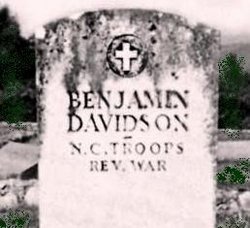Before the Revolution, Ben and his brothers James and William joined up with some of their Davidson cousins and began settling in the western part of North Carolina. Benjamin married a woman believed to be Ann Patton sometime around 1760 ...
During the Revolutionary War, Benjamin Davidson, along with several of his brothers and cousins joined in the struggle for Independence. The history of this Davidson family is reflected in the cousins named William Davidson. One, General William Lee Davidson, served with distinction until killed at the Battle of Chadd's Ford in 1781; Davidson College is named for him, as are Davidson Counties in North Carolina and Tennessee. Another cousin was Major William Davidson who became one of the leading men of Buncombe County. His brother, Colonel William Davidson, was one of the organizers for Buncombe County in 1792 and went on to become one of the original settlers of Morgan County, Tennessee. Ben served with distinction at King's Mountain under the command of Major Joseph McDowell.
Ben may have used his Military Land Warrants earned by service in the War to obtain land in what is now Transylvania County. He entered several claims during the 1780s. However, at the time of the 1790 census, he was listed in Morgan District in Burke County with a family of 10 children ...
Ben and a William Davidson – likely, Major William Davidson - became settlers near a stream - now called Davidson's River in Ben's honor - near its juncture with the French Broad River. Ben is said to have built the first house in the region, and it became a meeting place for travelers and for traveling ministers to hold services for the residents of the area.
It is believed that about 1800 Ben set aside some land and built where the Davidson River Presbyterian Church was built. Originally, it was called a "meeting house" because Presbyterians, Baptists, and Methodists were welcomed to worship there. His son-in-law Rev. Samuel Davis was the pastor at the time. In the narthex of the present day Brevard-Davidson River Presbyterian Church is a huge stone from the fireplace of Ben Davidson's home.
Benjamin Davidson deeded his home place to go to his daughter Rixey after his death on the condition that she take care of her mother. We would know much less about Ben's family of two sons and nine daughter were it not for a court case in the 1850s over that land that happened after Rixey's death in the 1840s and her only child's death in the 1850s.
Davison/Davidson Family, Robert Stephens Hand, (2nd Ed., 1991), p. 161
Before the Revolution, Ben and his brothers James and William joined up with some of their Davidson cousins and began settling in the western part of North Carolina. Benjamin married a woman believed to be Ann Patton sometime around 1760 ...
During the Revolutionary War, Benjamin Davidson, along with several of his brothers and cousins joined in the struggle for Independence. The history of this Davidson family is reflected in the cousins named William Davidson. One, General William Lee Davidson, served with distinction until killed at the Battle of Chadd's Ford in 1781; Davidson College is named for him, as are Davidson Counties in North Carolina and Tennessee. Another cousin was Major William Davidson who became one of the leading men of Buncombe County. His brother, Colonel William Davidson, was one of the organizers for Buncombe County in 1792 and went on to become one of the original settlers of Morgan County, Tennessee. Ben served with distinction at King's Mountain under the command of Major Joseph McDowell.
Ben may have used his Military Land Warrants earned by service in the War to obtain land in what is now Transylvania County. He entered several claims during the 1780s. However, at the time of the 1790 census, he was listed in Morgan District in Burke County with a family of 10 children ...
Ben and a William Davidson – likely, Major William Davidson - became settlers near a stream - now called Davidson's River in Ben's honor - near its juncture with the French Broad River. Ben is said to have built the first house in the region, and it became a meeting place for travelers and for traveling ministers to hold services for the residents of the area.
It is believed that about 1800 Ben set aside some land and built where the Davidson River Presbyterian Church was built. Originally, it was called a "meeting house" because Presbyterians, Baptists, and Methodists were welcomed to worship there. His son-in-law Rev. Samuel Davis was the pastor at the time. In the narthex of the present day Brevard-Davidson River Presbyterian Church is a huge stone from the fireplace of Ben Davidson's home.
Benjamin Davidson deeded his home place to go to his daughter Rixey after his death on the condition that she take care of her mother. We would know much less about Ben's family of two sons and nine daughter were it not for a court case in the 1850s over that land that happened after Rixey's death in the 1840s and her only child's death in the 1850s.
Davison/Davidson Family, Robert Stephens Hand, (2nd Ed., 1991), p. 161
Gravesite Details
Abstract of Graves of Revolutionary Patriots, Vol.1, p. Serial: 12172; Volume: 4










